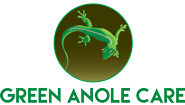Obtaining feed:
Basic feed can be obtained from local pet stores. You can purchase a small cricket pen which will accommodate two dozen crickets. If your pet store sells “small” and “large” crickets, I recommend opting for the small variety. Green anoles, particularly juvenile anoles, may become intimidated by larger crickets and refuse to eat until they are removed from the terrarium.
A varied diet is best for a healthy green anole. Your local pet store may stock wax worms, flies, moths, roach nymphs and other goodies suitable for feeding. Despite what store associates may tell you, mealworms are NOT a good food choice for anoles due to their chitinous exoskeleton which hampers nutrient absorption and can cause digestive problems. For a fairly comprehensive list of food choices, check our Diet page.
Some green anoles have been known to eat fruit-flavored baby food. This should only be used as an emergency food and should not be left inside the terrarium uneaten as it will spoil.
Wax worms should not be fed in excess as this can obesity. Green anoles do love them — they make a great treat!
Green anole hatchlings can be fed leafhoppers, flightless fruit flies, and pinhead crickets. If you are expecting hatchlings and are unskilled at catching live insects, you should make accommodations to find feed in advance as these can be harder to obtain.
When you’re ready for the next level, check our extensive guides on Catching Wild Insects and Raising Insects.
Feeding time:
Green anoles are opportunistic feeders. They will eat as much as they can whenever prey items are available.
Feeding every day or every other day works out fine. For crickets, I simply toss in one or two within my anole’s field of vision. If they are hungry, they will normally spring into action within a minute or two.
For refrigerated insects, make sure they come out of dormancy before you place them into the terrarium. For refrigerated wax worms, I blow them with warm air for 30 seconds and cup them in my hands to warm them slightly before placing them into the terrarium near my anoles.
Green anoles will usually have a marked increase in appetite in the spring and a decrease in the fall.
You should also dust the prey items with a calcium supplement once a week. You can use any of the commercial products that don’t contain D3. One of the best sources is to go to your local health food store and get either calcium carbonate or calcium lactate capsules or tablets. You can empty the capsules or grind the tablets into powder and dust the prey items. Put a small amount of the powder in a small plastic bag, add some prey items, and gently shake until they are covered. Then, dump them into the enclosure.
Be sure to remove any live prey items which are not eaten. If this is impossible or very difficult, at least leave food inside for the insects to eat to ensure they don’t go after your anoles instead!
